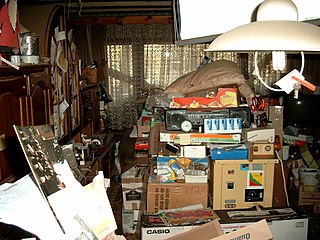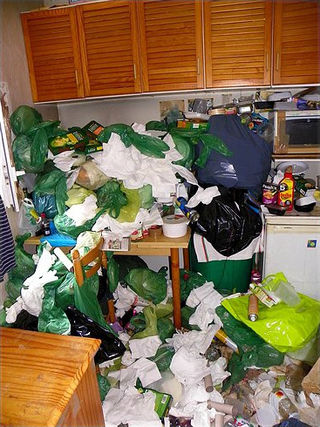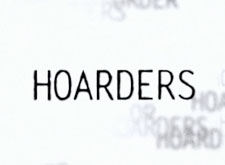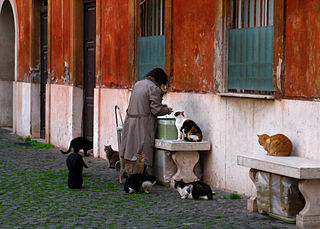An animal is a multicellular, eukaryotic organism of the kingdom Animalia or Metazoa.

A phobia is an anxiety disorder, defined by a persistent and excessive fear of an object or situation. Phobias typically result in a rapid onset of fear and are usually present for more than six months. Those affected go to great lengths to avoid the situation or object, to a degree greater than the actual danger posed. If the object or situation cannot be avoided, they experience significant distress. Other symptoms can include fainting, which may occur in blood or injury phobia, and panic attacks, often found in agoraphobia and emetophobia. Around 75% of those with phobias have multiple phobias.
Reaction may refer to a process or to a response to an action, event, or exposure.

Hoarding disorder (HD) or Plyushkin's disorder, is a mental disorder characterised by persistent difficulty in parting with possessions and engaging in excessive acquisition of items that are not needed or for which no space is available. This results in severely cluttered living spaces, distress, and impairment in personal, family, social, educational, occupational, or other important areas of functioning. Excessive acquisition is characterized by repetitive urges or behaviours related to amassing or buying property. Difficulty discarding possessions is characterized by a perceived need to save items and distress associated with discarding them. Accumulation of possessions results in living spaces becoming cluttered to the point that their use or safety is compromised. It is recognised by the eleventh revision of the International Classification of Diseases (ICD-11) and the Diagnostic and Statistical Manual of Mental Disorders, 5th edition (DSM-5).

Hoarding is the act of engaging in excessive acquisition of items that are not needed or for which no space is available.

Animal hoarding, sometimes called Noah syndrome, is keeping a higher-than-usual number of animals as domestic pets without the ability to properly house or care for them, while at the same time denying this inability. Compulsive hoarding can be characterized as a symptom of a mental disorder rather than deliberate cruelty towards animals. Hoarders are deeply attached to their pets and find it extremely difficult to let the pets go. They typically cannot comprehend that they are harming their pets by failing to provide them with proper care. Hoarders tend to believe that they provide the right amount of care for them. The American Society for the Prevention of Cruelty to Animals provides a "Hoarding Prevention Team", which works with hoarders to help them attain a manageable and healthy number of pets.
Sex is the biological distinction of an organism between male and female.

Hoarding or caching in animal behavior is the storage of food in locations hidden from the sight of both conspecifics and members of other species. Most commonly, the function of hoarding or caching is to store food in times of surplus for times when food is less plentiful. However, there is evidence that some amount of caching or hoarding is done in order to ripen the food, called ripening caching. The term hoarding is most typically used for rodents, whereas caching is more commonly used in reference to birds, but the behaviors in both animal groups are quite similar.
Cache, caching, or caché may refer to:

Diogenes syndrome, also known as senile squalor syndrome, is a disorder characterized by extreme self-neglect, domestic squalor, social withdrawal, apathy, compulsive hoarding of garbage or animals, and a lack of shame. Affected people may also display symptoms of catatonia.

A hoard or hoarding was a temporary wooden shed-like construction on the exterior of a castle during a siege that enabled the defenders to improve their field of fire along the length of a wall and, most particularly, directly downwards towards the bottom of the wall. The latter function was the purpose of the invention of machicolations, which were an improvement on hoardings, not least because masonry is fire proof. Machicolations are also permanent and always ready for a siege.

Hoarders is an American documentary reality television series that debuted on A&E on August 17, 2009. The show depicts the real-life struggles and treatment of people who suffer from compulsive hoarding disorder.

Hoarding in economics refers to the concept of purchasing and storing a large amount of product belonging to a particular market, creating scarcity of that product, and ultimately driving the price of that product up. Commonly hoarded products include assets such as money, gold and public securities, as well as vital goods such as fuel and medicine. Consumers are primarily hoarding resources so that they can maintain their current consumption rate in the event of a shortage. Hoarding resources can prevent or slow products or commodities from traveling through the economy. Subsequently, this may cause the product or commodity to become scarce, causing the value of the resource to rise.

A cat lady is a cultural archetype or stock character, most often depicted as a white woman, a middle-aged or elderly spinster or widow, who has many cats. The term may be pejorative, or it may be affectionately embraced.
Hoarding: Buried Alive is an American documentary television series that premiered on TLC on March 14, 2010. The show follows hoarders through their life experiences and helps them learn to manage their illness.
"Insheeption" is the tenth episode of the fourteenth season of the American animated television series South Park, and the 205th episode of the series overall. It premiered October 20, 2010 on Comedy Central in the United States. In the episode, Stan and Mr. Mackey suffer a hoarding disorder. In an attempt to find the cause for it, they get trapped in Mr. Mackey's dream. The episode spoofs the TV show Hoarders, Hoarding: Buried Alive, and the film Inception.
David F. Tolin is an American clinical psychologist.

Digital hoarding is defined by researchers as an emerging sub-type of hoarding disorder characterized by individuals collecting excessive digital material which leads to those individuals experiencing stress and disorganization. Digital hoarding takes place in electronic environments where information is stored digitally. The term gained popularity among online forums and in the media before receiving scholarly attention. Research indicates there may be correlation between individuals who exhibit physical and digital hoarding behaviors and acknowledges there is a lack of psychological literature on the subject.










